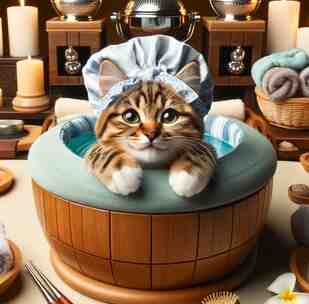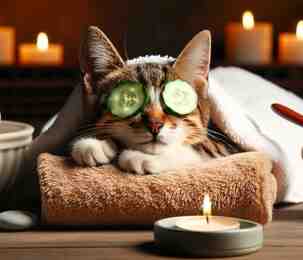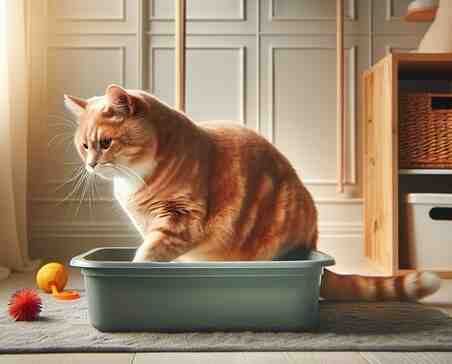Feline inappropriate urination can be frustrating for cat owners. Understanding the reasons behind this behavior is crucial in finding a solution. Stress, medical issues, and territorial marking are common causes. Addressing these factors through environmental enrichment, litter box management, and veterinary care can help resolve the problem and restore harmony in your home.

Home Cat Grooming 101: Essential Tips for a Healthy, Happy Feline
Introduction to Home Cat Grooming: Why It’s Important
Cats are known for their cleanliness and grooming habits. However, even the most fastidious feline can benefit from regular grooming sessions. Home cat grooming not only helps maintain your cat’s appearance but also promotes their overall health and well-being. By understanding the importance of grooming and learning the essential tips and techniques, you can ensure that your furry friend remains healthy and happy.
Understanding Your Cat’s Grooming Needs
Before diving into the world of home cat grooming, it is crucial to understand your cat’s specific grooming needs. Different cat breeds have different coat types, which require varying levels of care. For example, long-haired breeds like Persians and Maine Coons need more frequent brushing to prevent matting and hairballs. On the other hand, short-haired breeds like Siamese and Burmese may require less brushing but still benefit from regular grooming to remove loose hair and debris.
Essential Tools for Home Cat Grooming
To effectively groom your cat at home, you will need a few essential cat grooming tools. These include a cat brush or comb, cat-specific shampoo, nail clippers, dental care products, ear cleaning solution, and eye wipes. It is important to invest in high-quality grooming tools that are specifically designed for cats to ensure their safety and comfort during the grooming process.
The Art of Brushing: Techniques for Different Cat Breeds
Brushing is a fundamental aspect of home cat grooming, regardless of your cat’s breed. Regular brushing helps remove loose hair, prevents matting, and stimulates the production of natural oils that keep the coat healthy and shiny. However, the technique and frequency of brushing may vary depending on your cat’s breed.
For long-haired cats, use a wide-toothed comb or a slicker brush to gently remove tangles and prevent matting. Short-haired cats can be brushed with a soft-bristle brush or a rubber grooming mitt to remove loose hair.
Bathing Your Cat: When and How to Do It Right
Bathing a cat can be a challenging task, as most cats are not fond of water. However, there are instances when a bath becomes necessary, such as when your cat gets into something sticky or dirty. When bathing your cat, it is important to use cat-specific shampoo and lukewarm water. Start by wetting your cat’s fur, avoiding the head and ears.
Gently massage the shampoo into the coat, being careful not to get it into their eyes or ears. Rinse thoroughly and dry your cat with a towel or a low-heat blow dryer. It is essential to make the bathing experience as stress-free as possible by providing treats and positive reinforcement.
Nail Trimming: A Step-by-Step Guide for Cat Owners
Trimming your cat’s nails is an essential part of home cat grooming. Overgrown nails can cause discomfort and even lead to injury.
To trim your cat’s nails, start by getting them comfortable with the process. Gently touch and handle their paws regularly to desensitize them. Use cat-specific nail clippers and trim only the sharp tips of the nails, being careful not to cut into the quick, which can cause bleeding.
If your cat is resistant to nail trimming, consider seeking professional help or using alternative methods like scratching posts to naturally wear down their nails.
Dental Care: Maintaining Your Cat’s Oral Health
Oral health is often overlooked in home cat grooming routines. However, dental care is crucial for preventing dental diseases and maintaining your cat’s overall health.
Regular brushing with a cat-specific toothbrush and toothpaste helps remove plaque and tartar buildup. Additionally, providing dental treats and toys designed to promote oral hygiene can help keep your cat’s teeth clean and healthy. It is important to consult with your veterinarian for guidance on proper dental care techniques and products.
Ear Cleaning: Preventing Infections and Parasites
Cleaning your cat’s ears is an essential part of home cat grooming. Regular ear cleaning helps prevent infections and removes dirt, wax, and parasites. Use a cat-specific ear cleaning solution and a cotton ball or pad to gently clean the visible parts of the ear.
Avoid inserting anything into the ear canal, as it can cause injury. If you notice any signs of ear infection, such as redness, swelling, or discharge, consult your veterinarian for proper diagnosis and treatment.
Eye Care: Keeping Your Cat’s Eyes Bright and Healthy
Maintaining your cat’s eye health is another important aspect of home cat grooming. Regular eye care helps prevent eye infections and keeps your cat’s eyes bright and healthy. Use cat-specific eye wipes or a damp cloth to gently wipe away any discharge or debris from the corners of your cat’s eyes.
If you notice any signs of eye irritation, such as redness, swelling, or excessive tearing, consult your veterinarian for proper evaluation and treatment.
Dealing with Hairballs: Prevention and Treatment
Hairballs are a common issue for cats, especially those with long hair. While grooming helps reduce the occurrence of hairballs, it is important to take additional measures to prevent and treat them. Regular brushing helps remove loose hair, reducing the amount of hair your cat ingests during self-grooming.
Additionally, providing a hairball prevention diet or using hairball remedies can help lubricate the digestive tract and facilitate the passage of hairballs. If your cat experiences frequent or severe hairballs, consult your veterinarian for further evaluation and guidance.
Professional Grooming vs. Home Grooming: What’s Best for Your Cat?

Additionally, professional grooming can be beneficial for cats who are anxious or resistant to home grooming. However, for routine grooming needs, home grooming can be a cost-effective and convenient option. It is important to assess your cat’s specific grooming requirements and consult with your veterinarian or a professional groomer to determine the best approach for your cat.
Conclusion: Creating a Regular Grooming Routine for Your Cat
In conclusion, home cat grooming is an essential aspect of responsible pet ownership. By understanding your cat’s grooming needs and following the essential tips and techniques discussed above, you can ensure that your feline friend remains healthy, happy, and well-groomed.
Establishing a regular grooming routine not only helps maintain your cat’s appearance but also promotes their overall well-being. Remember to be patient, provide positive reinforcement, and seek professional help when needed. With proper grooming, your cat will not only look their best but also feel their best.



This Post Has 0 Comments